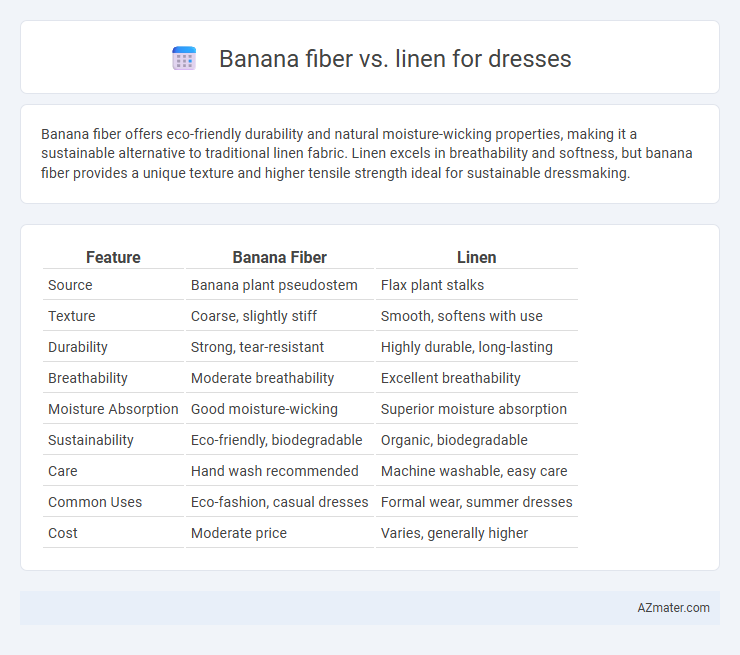Banana fiber offers eco-friendly durability and natural moisture-wicking properties, making it a sustainable alternative to traditional linen fabric. Linen excels in breathability and softness, but banana fiber provides a unique texture and higher tensile strength ideal for sustainable dressmaking.
Table of Comparison
| Feature | Banana Fiber | Linen |
|---|---|---|
| Source | Banana plant pseudostem | Flax plant stalks |
| Texture | Coarse, slightly stiff | Smooth, softens with use |
| Durability | Strong, tear-resistant | Highly durable, long-lasting |
| Breathability | Moderate breathability | Excellent breathability |
| Moisture Absorption | Good moisture-wicking | Superior moisture absorption |
| Sustainability | Eco-friendly, biodegradable | Organic, biodegradable |
| Care | Hand wash recommended | Machine washable, easy care |
| Common Uses | Eco-fashion, casual dresses | Formal wear, summer dresses |
| Cost | Moderate price | Varies, generally higher |
Introduction to Banana Fiber and Linen
Banana fiber, derived from the pseudostem of the banana plant, offers a sustainable and biodegradable alternative to traditional fibers, known for its strength and natural sheen. Linen, made from flax fibers, has been prized for centuries due to its breathability, durability, and smooth texture, making it a popular choice in fashion design. Both fibers provide eco-friendly options with distinct tactile qualities and environmental benefits for dressmaking.
Origin and Production Processes
Banana fiber originates from the pseudostem of the banana plant, primarily cultivated in tropical regions such as India, the Philippines, and Nepal, where the fiber is extracted through retting and scraping processes. Linen, derived from the flax plant grown mainly in Europe, involves harvesting, dew retting, and mechanical or hand breaking to produce fine, strong fibers. While banana fiber extraction emphasizes sustainable use of agricultural waste, linen production depends on careful retting and scutching to achieve its characteristic smoothness and durability.
Environmental Impact Comparison
Banana fiber, derived from the pseudostem of banana plants, is a highly sustainable textile choice due to its renewable source and minimal agricultural waste production, whereas linen is made from flax plants, which require less water and pesticides compared to cotton but still involve significant land use. The production of banana fiber generates lower carbon emissions and promotes waste reduction by utilizing plant parts that would otherwise be discarded. In contrast, linen processing involves retting and scutching, which can contribute to water pollution if not managed sustainably, making banana fiber a preferable option for eco-conscious fashion focused on reducing environmental footprints.
Texture and Comfort Differences
Banana fiber offers a coarser texture with natural stiffness, resulting in a breathable yet slightly rough feel ideal for casual or rustic-style dresses. Linen provides a smoother, softer touch with excellent moisture-wicking properties, enhancing comfort especially in warm climates. The comfort of banana fiber may vary based on processing, while linen consistently delivers lightweight, cool wearability.
Durability and Longevity
Banana fiber offers exceptional durability due to its long, strong cellulose strands, making it resistant to wear and tear compared to linen, which tends to be more prone to fraying over time. Linen, derived from flax plants, provides moderate longevity but requires careful maintenance to avoid shrinkage and weakening of fibers. For dress fabrics, banana fiber ensures extended lifespan and resilience, especially in humid conditions where linen may degrade faster.
Breathability and Moisture Absorption
Banana fiber offers exceptional breathability due to its natural porous structure, making it ideal for warm climates and active wear. Linen, made from flax fibers, also provides excellent airflow and moisture-wicking properties, ensuring high comfort by quickly absorbing and evaporating sweat. Both fibers enhance breathability and moisture absorption, but banana fiber tends to be softer and more eco-friendly, while linen is known for its durability and crisp texture.
Aesthetic Qualities and Versatility
Banana fiber offers a natural sheen and a unique texture that imparts an earthy, rustic elegance to dresses, contrasting with linen's crisp, smooth finish that conveys a classic, refined look. The durability and slight stiffness of banana fiber create structured silhouettes suitable for statement pieces, while linen's breathable and flexible nature allows for flowing, effortless designs adaptable to casual or formal wear. Both fibers excel in sustainable fashion, but banana fiber's distinctive aesthetic and sturdy versatility make it ideal for eco-conscious designers seeking innovative textures in dressmaking.
Maintenance and Care Requirements
Banana fiber dresses require gentle hand washing with mild detergent and air drying to maintain their strength and texture, while linen garments can be machine washed on a gentle cycle but benefit from ironing to reduce wrinkles. Both fabrics are breathable and durable, yet banana fiber is more susceptible to water damage and should be kept away from prolonged moisture exposure. Linen's natural resilience allows for more frequent laundering, though it may shrink without proper care.
Cost and Market Availability
Banana fiber is generally more affordable and sustainable compared to linen, as it is derived from the waste of banana plants and requires less water and pesticides for cultivation. Linen, made from flax fibers, tends to be more expensive due to the labor-intensive harvesting process and its established market demand. Market availability favors linen, widely accessible globally, while banana fiber remains niche with limited suppliers, impacting its cost-effectiveness and distribution in dress manufacturing.
Final Verdict: Which Is Better for Dresses?
Banana fiber offers exceptional sustainability with natural antibacterial properties and superior breathability, making it ideal for eco-conscious dressmakers seeking lightweight, breathable fabrics. Linen provides durability, a luxurious texture, and excellent moisture-wicking abilities but often requires more intensive cultivation and processing. For dresses, banana fiber stands out for its eco-friendliness and comfort, while linen excels in durability and classic aesthetic, making the choice dependent on the wearer's priority between sustainability and traditional fabric qualities.

Infographic: Banana fiber vs Linen for Dress
 azmater.com
azmater.com